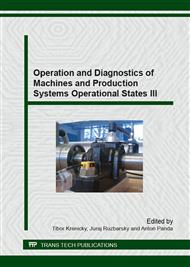[1]
M. Gombár, A. Vagaská, J. Kmec, P. Michal, Microhardness of the coatings created by anodic oxidation of aluminum, Applied Mechanics and Materials 308 (2013) 95-100.
DOI: 10.4028/www.scientific.net/amm.308.95
Google Scholar
[2]
M. Badida, M. Gombar, L. Sobotova, J. Kmec, A. Vagaská, P. Michal, The influence of sodium chloride on the resulting AAO film thickness", Advanced Materials Research 816 (2013) 18-22.
DOI: 10.4028/www.scientific.net/amr.816-817.18
Google Scholar
[3]
M. Gombár, J. Kmec, M. Badida, L. Sobotová, A. Vagaská, P. Michal, The simulation of the temperature effects on the microhardness of anodic alumina oxide layers, Metalurgija 53/1 (2014) 59-62.
Google Scholar
[4]
M. Badida, M. Gombár, J. Kmec, L. Sobotová, A. Vagaská, P. Michal, Study of the influence of chemical composition of the electrolyte on microhardness of the layer formed by anodic oxidation of aluminium, Chemické Listy 107 (2012) 973-977.
DOI: 10.4028/www.scientific.net/amm.308.95
Google Scholar
[5]
P. Michal, A. Vagaská, M. Gombár, J. Kmec, Mathematical Modelling and Optimization of Technological Process Using Design of Experiments Methodology, Applied Mechanics and Materials 616 (2014) 61-68.
DOI: 10.4028/www.scientific.net/amm.616.61
Google Scholar
[6]
I. Tsangaraki-Kaplanogloua, S. Theohari , Th. Dimogerontakis, N. Kallithrakas-Kontos, W. Yar-Ming, K. Hong-Hsiang , K. Sheila, Effect of alloy types on the anodizing process of aluminum", Surface & Coatings Technology 200/8 (2006) 2634–2641.
DOI: 10.1016/j.surfcoat.2005.07.065
Google Scholar
[7]
G. Patermarakis, Development of a theory for the determination of the composition of the anodizing solution inside the pores during the growth of porous anodic Al2O3 films on aluminium by a transport phenomenon analysis, Journal of Electroanalytical Chemistry 447/1-2 (1998).
DOI: 10.1016/s0022-0728(97)00604-9
Google Scholar
[8]
T. Aerts, I. DeGraeve, G. Nelissen, J. Deconinck, S. Kubacki, E. Dick, H. Terryn, Experimental study and modelling of anodizing of aluminium in a wall-jetelectrode set-up in laminar and turbulent regime, Corrosion Science 51/7 (2009) 1482–1489.
DOI: 10.1016/j.corsci.2008.12.001
Google Scholar
[9]
T. Aerts, I. DeGraeve, G. Nelissen, Comparison between the influence of applied electrode and electrolyte temperatures on porous anodizing of aluminium, Electrochimica Acta 55/12 (2010) 3957–3965.
DOI: 10.1016/j.electacta.2010.02.044
Google Scholar
[10]
T. Aerts, T. Dimogerontakis, I. De Graeve, J. Fransaer, H. Terryn, Influence of the anodizing temperature on the porosity and the mechanical properties of the porous anodic oxide film, Surface & Coatings Technology 201/16-17 (2007) 7310–7317.
DOI: 10.1016/j.surfcoat.2007.01.044
Google Scholar
[11]
A. Vagaská, P. Michal, I. Bukovský, M. Gombár, J. Kmec, Mathematical modelling and description of the technological process of aluminum anodic oxidation by using the neural networks, International Journal of Materials 1 (2014) 9-16.
DOI: 10.4028/www.scientific.net/amm.616.61
Google Scholar
[12]
P. Michal, A. Vagaská, M. Gombár, J. Kmec, E. Spišák, D. Kučerka, Using Neural Networks to Design Predictive Model of Creation of Aluminium Oxide Layer, in: Proceedings of the International 18th Conference on Systems - CSCC 2014, Santorini Island, Greece, 2014, pp.168-173.
DOI: 10.1155/2015/253568
Google Scholar
[13]
A. Vagaská, P. Michal, M. Gombár, J. Kmec, E. Spišák, M. Badida, Modelling of the anodizing process of aluminum using neural networks, in: Proceedings of the 15th International Carpathian Control Conference - ICCC 2014, Veľké Karlovice, IEEE, 2014, pp.629-634.
DOI: 10.1109/carpathiancc.2014.6843681
Google Scholar
[14]
S. Hrehová, J. Mižáková, Using GUI of matlaband fuzzy principles for evaluating of some process quality, International Journal of Fuzzy Systems and Advanced Applications 1 (2014) 7-14.
Google Scholar
[15]
E. Evin, J. Kmec, E. Fechová, Optimizing of electric discharge texturing parameters of rolls of the rolling mill of steel sheets, Applied Mechanics and Materials 420 (2013) 78-84.
DOI: 10.4028/www.scientific.net/amm.420.78
Google Scholar
[16]
T. Krenický, Non-contact Study of Surfaces Created Using the AWJ Technology, Manufacturing Technology 15/1 (2015) 61-64.
DOI: 10.21062/ujep/x.2015/a/1213-2489/mt/15/1/61
Google Scholar
[17]
J. Piteľ, J. Mižák, Computational intelligence and low cost sensors in biomass combustion process, in: Proceedings of the 2013 IEEE Symposium Series on Computational Intelligence (SSCI): 2013 IEEE Symposium on Computational Intelligence in Control and Automation (CICA), Singapore, IEEE, 2013, pp.165-168.
DOI: 10.1109/cica.2013.6611681
Google Scholar
[18]
A. Hošovský, J. Mižáková, J. Piteľ, Improved Modeling of Pneumatic Muscle Actuator Using Recurrent Neural Network, in: Proc. of 2014 IEEE World Congress on Computational Intelligence: 2014 International Joint Conference on Neural Networks (IJCNN), Beijing, IEEE, 2014, pp.4019-4024.
DOI: 10.1109/ijcnn.2014.6889785
Google Scholar


